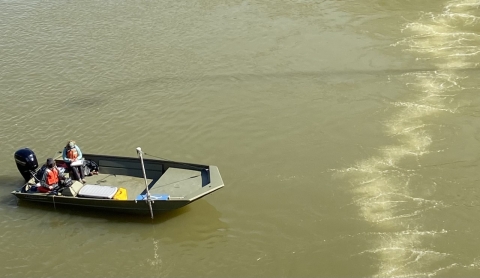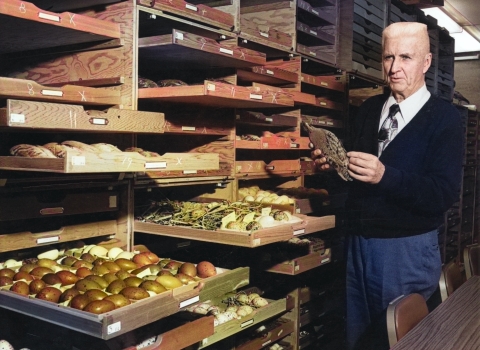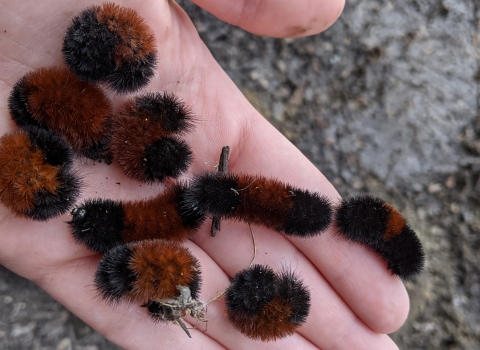Grand Rivers, Kentucky — The fate of millions of invasive carp — and fisheries along the Mississippi, Ohio, Illinois, Missouri, Tennessee and Cumberland rivers – hinges on the high-tech tools housed inside two, nondescript metal containers atop the bullnose that separates Lake Barkley’s lock from its dam.
The room-sized boxes contain the computers and compressors that serve as the brains of a bio-acoustic fish fence, or BAFF. The fence runs diagonally across the lock chamber, well below a boat’s keel. It emits a series of bubbles, sounds and lights designed to keep carp from passing further upstream and ravaging billion-dollar fishing grounds.
Jessica Morris, the fisheries program coordinator for the Kentucky Department of Fish and Wildlife Resources, monitors the BAFF and, along with colleagues, turns the system on, or off, each week. The fish fence, made in the United Kingdom and designed specifically for invasive carp, is in the midst of a three-year test run. Morris was cautiously optimistic that it will be successful, a sentiment bolstered by laboratory tests and U.S. Fish and Wildlife Service (Service) biologists.
“It seems to be working,” she said while walking the bullnose as silver carp jump straight out of the Cumberland River below. “I’m encouraged, but we’re not 100 percent sold that it’s the golden ticket. The next few months will be very important.”
Summertime is mostly when the fish spawn, travel farther upstream and become an all-around nuisance to anglers and boaters. There are four species of invasive carp -- bighead, black, grass and silver – with silver carp posing the biggest threat. They have voracious appetites. Silver carp eat plankton – algae and other microscopic organisms – which serve as the basic food source for native fish like crappie and largemouth bass. Black carp, with human-like molars, prey upon snails, mussels, and crayfish found throughout the Tennessee and other southern river systems.
Silver carp, aka “flying carp,” can also jump 10 feet out of the water. Tales of broken bones and worse proliferate among boaters. Motors and other loud noises spook silver carp sending the 10-to-50-pound fish skyward. But it’s the potential big-dollar damage done to the boating, fishing, and tourism industries that’s also worrisome. Recreational fishing in western Kentucky alone brings $1.2 billion annually.
‘Daunting’ problem
The carp were imported from Southeast Asia to Arkansas and Mississippi in the 1970s to help clean catfish farms and wastewater treatment ponds of weeds and parasites. Flood waters helped them escape. They headed up the Mississippi River and into the tributaries that reach into 31 states and Canada.
Silver and bighead carp, in particular, worked their way up the Ohio, Cumberland and Tennessee Rivers, and reached lakes Barkley and Kentucky a decade ago.
“The invasive carp problem is daunting,” said Rick Campbell, an aquatic conservation coordinator with the Service in South Carolina. “There’s a lot of work that has to be done. And the work we’re doing here is critical.”
Campbell and Evan Boone, a Service fish biologist out of Tupelo, Mississippi, spent a week this spring catching, tagging and relocating silver carp, and some native fish, on lakes Barkley and Kentucky. They were joined by biologists from the Service’s Midwest Region, the U.S. Army Corps of Engineers, and Kentucky’s fish and wildlife agency. Representatives from Fish Guidance Systems (FGS), the BAFF builder, and Innovasea, the fish-tag makers, were also on hand.
The Kentucky crew switched on its fish-finder upon nearing Barkley’s eastern shore on the upstream side of the dam. Once a school of silver carp was located — there are possibly millions of them in the lake — they threw the gill nets. The crew maneuvered the boat in corkscrew fashion to corral the fish.
The carp, entangled, thrashed about. With nowhere to run, the fish were hauled up, one by one, on to the Kentucky boat. The Service’s 22-foot skiff sidled up alongside and a dozen fish, still fighting, were handed over and placed in a large plastic tub. Boone throttled up and boogied across the lake to the Double Creek boat ramp where Jessica Morris and a fish-hauling truck awaited.
Morris took the fish — 400 silver carp and 15 grass carp captured that week — to the other side of the dam to rendezvous with another Service boat. Kennan Bruening and Dan Madziarz, out of the Carterville (Illinois) Fish and Wildlife Conservation Office, then ferried the fish upstream to a boatload of U.S. Geological Survey biologists embedding pea-sized transmitters in carp bellies. The fish were then released back into the Cumberland River just below the BAFF. The goal is to see how many fish cross the fish fence and head back upstream.
Protecting the Great Lakes
Morris leaned out over the bullnose and watched silver carp jump in the tailwaters below the massive Barkley dam. The BAFF hummed, but she couldn’t hear a thing from this height. Instead, she saw a ribbon of churning, white water — “a curtain of bubbles” — stretching from wall to wall.
“This is a high-head dam, so the only way to get through it, and further upstream, is past the BAFF and through the lock chamber,” Morris said. “We want to stop them here.”
The Service is leading the multiagency carp-deterrent effort which counts 70 federal, state, nonprofit, and private partners across the Mississippi River Basin. They’ve battled the alien invasion for more than two decades with most of the attention, and dollars, focused on keeping the fish from traveling up the Mississippi River and into the Great Lakes. All manner of deterrents, tracking devices and removal equipment – electric barriers, sound columns, bubble curtains, electro-fishing gear, acoustic telemetry – have been tested or deployed to monitor and thwart their upstream advance.
Electric fences have been installed in the Chicago area. The Army Corps is also spending an estimated $858 million on the Brandon Road Lock and Dam project along the Des Plaines River, about 40 miles from Lake Michigan, which includes an electric-acoustic-bubble barrier. The goal: keep carp from destroying the Great Lakes’ $7 billion fishing industry.
The U.S. Geological Survey studied the feasibility of an underwater, carbon-dioxide deterrent system on the Fox River near Kaukauna, Wisconsin. The Service, in 2014, deployed the “Magna Carpa,” a customized boat with wing-like nets that winches carp out of the water once they’ve been electro-stunned. States also subsidize commercial fishermen to haul millions of pounds of carp annually from streams throughout the Mississippi River system.
In all, dozens of prevention and control projects are underway across the river basins that feed into the Mississippi.
Kentucky is at the forefront of the latest battle. The state’s wildlife agency, relying on expertise and assistance from the Service and other state and federal agencies, rolled out last year the so-called Modified-Unified Method, or MUM, to corral carp. Boats, equipped with nets and underwater speakers, steered carp into a cove and stunned them with electricity before scooping them up. And it was largely effective: trials in Missouri and Illinois removed as much as 90 percent of the fish from targeted waters.
The “brains” of the system
And then there's the BAFF, which is undergoing an “unprecedented” field test on Lake Barkley. The fish fence came on line in 2019. It’s about a third of the way through its field trial. The tests will show how effectively the trifecta of sound, light and pressure deters carp, as well as the BAFF’s impact on commercial navigation and recreational fishing. Barkley is an optimal location for the trial: carp have already passed through the lock so the fence should determine if their future passage can be slowed or stopped.
The BAFF is one complex piece of hardware. A concrete shell, 200 feet long, at the bottom of the river channel, is studded with bubble pipes, speakers and high-intensity lighting that shoot air, sound, and light beams roughly 60 feet upward to the water’s surface. Electrical lines and air hoses run from the concrete trough to the bank of computers and compressors housed in the two steel sheds. Local contractors dubbed the BAFF the “fish disco.”
Carp are very sensitive to sounds. FGS conducted scores of audiometric tests to determine which sounds and vibrations most displease carp (without, hopefully, bothering other fish). An array of telemetric receivers on either side of the bubble curtain tracks the tagged fish. Boaters may hear the sounds when passing over the fish fence. At night, they’ll probably see flashing white lights.
“Every project we do teaches us something new, and Barkley lock is no exception,” said David Lambert, FGS’s managing director. “Over the last few months, for example, we have upgraded the sound projectors and installed other improvements to the BAFF. The system is specifically designed to help stop the spread of invasive carp. It is the culmination of 25 years of research, development and experience.”
Kentucky’s Morris, during a quick tour, unlocked the shed housing the computers that monitor the sound and light systems. One screen provided up-to-the-minute information on the BAFF’s five separate sections. Another recorded tagged-carp movements – one ping every three to five seconds -- picked up by hydrophones. USGS can access the data remotely.
“These are the brains of the sound and light systems,” Morris said before turning the BAFF off. “It’s all very cool.”
The technology, installation and three-year trial is financed by the Service via the EPA’s Great Lakes Restoration Initiative and the Invasive Carp Regional Coordinating Committee.
If successful, BAFFs may be installed at strategic pinch-points along the Tennessee, Illinois and other carp-infested streams. In a University of Minnesota lab, a small-scale BAFF deterred up to 97 percent of silver and bighead carp. The results were replicated along an Illinois creek. Early returns are favorable at Lake Barkley.
Two-hundred-and-fifty-four silver carp were tagged in November 2020. When the BAFF was off, 57 silvers crossed the fish fence 129 times. When it was on, only four tagged silver carp crossed the BAFF seven times.
“These are pretty big contrasts in numbers,” said Teresa Lewis, the division chief for Fish and Aquatic Conservation in Washington, during a recent BAFF presentation for partner agencies. “It’s still too early to tell, and we haven’t collected enough data, but we can say it’s a very exciting place we are in now.”





